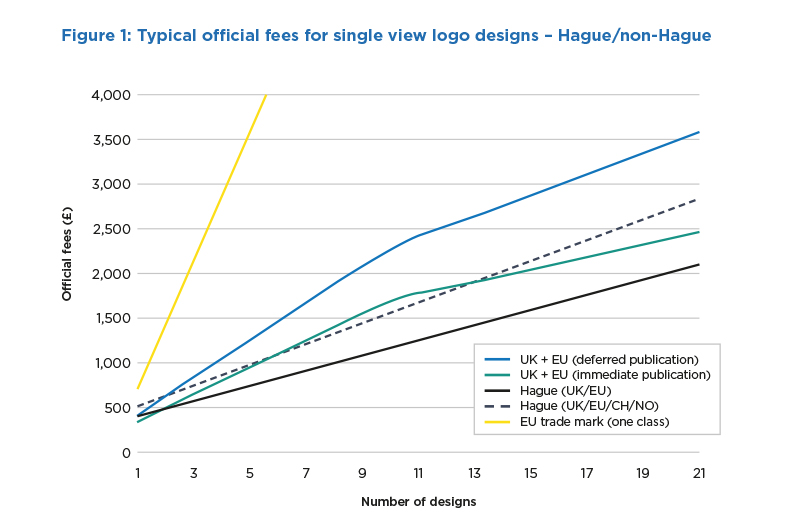How about Hague?
There are benefits to be reaped from this registration system, says William Burrell.

In the context of protecting design registrations in Europe, what often first springs to mind is its application for protecting physical products with a 3D aspect, or perhaps even a graphical user interface.
Often overlooked, however, is how a design registration can be used to protect other designs, such as surface ornamentation, graphical symbols and logos.
This is quite right perhaps, since when it comes to such 2D designs, other forms of IP protection are more obvious – most notably trade mark protection.
That being said, it always pays to consider whether design registration protection could act as a useful supplement to (or replacement for) trade mark protection.
For instance, a logo or some other new graphical mark/symbol may well not be that distinctive at the point of conception, making trade mark protection at an early point impossible.
Equally, it may be that such a mark/symbol is intended to only have a relatively short lifespan (perhaps only a few years), which may make the cost of trade mark protection unwieldy.
In these instances, design registration protection comes neatly into the frame.
Indeed, unlike trade mark protection, design registration protection makes no requirement for the design in question to have sufficient distinctiveness.
As long as the design has not been publicly disclosed for an undue period of time (usually less than a year, noting many territories in Europe operate a 12‑month novelty grace period in respect of design registration protection), the design may notionally be registrable.
Another advantage is that, in many parts of Europe, a design registration can often be achieved in just a few weeks, making protection readily applicable to those marks/symbols that are intended to have a limited period of use.
Lack of limits
Design registration protection in many European territories also has the distinct advantage that it is not limited to a particular set of goods.
So, unlike a trade mark, which requires protection to be applied for in respect of particular goods and services, design registration protection in the UK and EU will notionally cover usage of the design in respect of any goods employing that design.
With its usefulness so established, what is the best route for obtaining design registration protection? There are two main routes:
1. Protection via separate national design registrations in each territory of interest (eg, a separate pair of UK and EU registered design applications); or
2. Protection via the Hague design registration system.
While the ‘national’ route may have some advantages, in the instances we’ve highlighted – and particularly where the idea is to seek design registration protection in Europe for multiple marks/symbols simultaneously – usage of the Hague design registration system may be the most cost‑effective route.
Indeed, at least in respect of design registration protection in the UK/EU (including Germany), it is possible to pursue multiple designs in a single registered design application.
This can result in cost savings compared with pursuing each design in a separate application.

To place this in context, Figure 1 (above) outlines the approximate official fees (in pounds) for pursuing design protection in respect of a set of marks/designs via the national route or the Hague design registration system as part of a given registered design application.
One thing to note immediately is that if design registration protection is sought via the national route in the UK/EU, additional official fees are payable if deferred publication is requested (this allows the drawings of each design to be kept unpublished for a period of time after the design registration is allowed).
Under the Hague design registration system, however, whether deferred publication is requested or not, the official fees stay the same.
What is clear, however, is that, particularly if there are a few marks/symbols being sought for protection at the same time, it can often be cheaper to obtain the design registration protection via the Hague system.
Economy of scale
Figure 1 also includes the official fees for pursuing a Hague design registration when more comprehensive European protection is required – namely, protection in all of the UK, EU, Norway and Switzerland (Norway and Switzerland also allow registered design protection for logos/symbols).
In these cases, the cost saving from using the Hague design registration system really comes into its own.
It is also stark that the official fees for design registration protection are markedly lower than the official fees for obtaining an EU trade mark (EUTM) in just one class.
Indeed, the official fees to pursue a Hague design registration in all of the UK, EU, Norway and Switzerland are cheaper than the official fee to obtain an EUTM in just one class.
Tempering the virtues of design registration protection that we’ve discussed, it must be noted that the versatility of trade mark protection may prove more valuable over the longer term.
Design registration protection in many of the above territories is limited to a maximum duration of 25 years, whereas a trade mark may in principle have an unlimited duration (so long as usage of the trade mark is maintained over the entire period).
Moreover, a trade mark may be notionally enforced in respect of third‑party marks that are confusingly similar to the mark in question; a design registration in these instances may be more difficult to enforce.
In any case, it is clear that the design registration system in Europe is an extremely powerful and cost‑effective tool, and can be an effective supplement to any trade mark protection considered for a potential set of graphical marks/logos/symbols intended for use in Europe.
It may also compensate for a lack of trade mark protection where such protection is deemed not practically advisable or too expensive. Indeed, considering the modest official fees involved, the protection gained from such a registration may represent excellent value for money.
William Burrell is a Patent Attorney and Partner at D Young & Co LLP
Full issue






